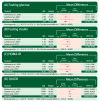Effects of Curcumin on Glycemic Control and Lipid Profile in Polycystic Ovary Syndrome: Systematic Review with Meta-Analysis and Trial Sequential Analysis
- PMID: 33669954
- PMCID: PMC7924860
- DOI: 10.3390/nu13020684
Effects of Curcumin on Glycemic Control and Lipid Profile in Polycystic Ovary Syndrome: Systematic Review with Meta-Analysis and Trial Sequential Analysis
Abstract
The therapeutic effects of curcumin for polycystic ovary syndrome (PCOS) remain inconclusive. The present study aims to evaluate the effects of curcumin on glycemic control and lipid profile in patients with PCOS. PubMed, Embase, Scopus, Web of Science, and Cochrane Library were searched from the inception through 28 November 2020. Randomized control trials (RCTs), which enrolled adult patients with PCOS, compared curcumin with placebo regarding the glycemic control and lipid profile, and reported sufficient information for performing meta-analysis, were included. Three RCTs were included. Curcumin significantly improves fasting glucose (mean difference (MD): -2.77, 95% confidence interval (CI): -4.16 to -1.38), fasting insulin (MD: -1.33, 95% CI: -2.18 to -0.49), Homeostasis Model Assessment of Insulin Resistance (HOMA-IR) (MD: -0.32, 95% CI: -0.52 to -0.12), and quantitative insulin sensitivity check index (QUICKI) (MD: 0.010, 95% CI: 0.003-0.018). It also significantly improves high-density lipoprotein (MD: 1.92, 95% CI: 0.33-3.51) and total cholesterol (MD: -12.45, 95% CI: -22.05 to -2.85). In contrast, there is no statistically significant difference in the improvement in low-density lipoprotein (MD: -6.02, 95% CI: -26.66 to 14.62) and triglyceride (MD: 8.22, 95% CI: -26.10 to 42.53) between curcumin and placebo. The results of the fasting glucose, fasting insulin, HOMA-IR, QUICKI, and total cholesterol are conclusive as indicated by the trial sequential analysis. Curcumin may improve glycemic control and lipid metabolism in patients with PCOS and metabolic abnormality without significant adverse effects. Further studies are advocated to investigate the potential effects of curcumin on hyperandrogenism.
Keywords: cholesterol; curcumin; insulin resistance; meta-analysis; polycystic ovary syndrome; trial sequential analysis.
Conflict of interest statement
The authors declare no conflict of interest.
Figures




References
-
- Lauritsen M.P., Bentzen J.G., Pinborg A., Loft A., Forman J.L., Thuesen L.L., Cohen A., Hougaard D.M., Nyboe Andersen A. The prevalence of polycystic ovary syndrome in a normal population according to the Rotterdam criteria versus revised criteria including anti-Mullerian hormone. Hum. Reprod. 2014;29:791–801. doi: 10.1093/humrep/det469. - DOI - PubMed
-
- Chang J., Azziz R., Legro R., Dewailly D., Franks S., Tarlatzis R., Fauser B., Balen A., Bouchard P., Dalgien E., et al. Revised 2003 consensus on diagnostic criteria and long-term health risks related to polycystic ovary syndrome. Fertil. Steril. 2004;81:19–25. doi: 10.1016/j.fertnstert.2003.10.004. - DOI - PubMed
Publication types
MeSH terms
Substances
Grants and funding
LinkOut - more resources
Full Text Sources
Other Literature Sources
Medical

